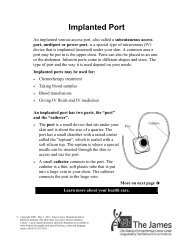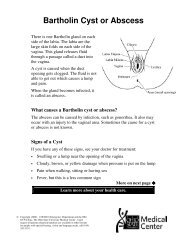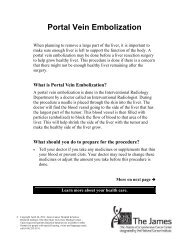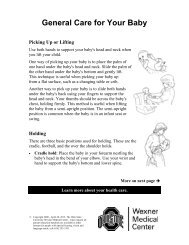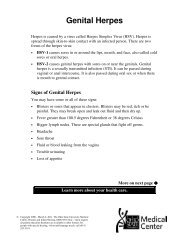Possible Problems with Peritoneal Dialysis - Patient Education Home
Possible Problems with Peritoneal Dialysis - Patient Education Home
Possible Problems with Peritoneal Dialysis - Patient Education Home
You also want an ePaper? Increase the reach of your titles
YUMPU automatically turns print PDFs into web optimized ePapers that Google loves.
Page 6<br />
<strong>Problems</strong> <strong>with</strong> Solution Flow<br />
If you have trouble <strong>with</strong> solution flow during PD exchanges call your<br />
doctor or CAPD unit.<br />
Solution Problem Treatment<br />
Poor solution flow<br />
into peritoneal<br />
cavity<br />
Fibrin<br />
White strands of<br />
protein or “egg<br />
white” seen in the<br />
drained dialysis<br />
solution can cause<br />
slow drainage or<br />
inflow<br />
Poor Solution Flow<br />
out of <strong>Peritoneal</strong><br />
Cavity<br />
Constipation<br />
Constipation is the<br />
most common cause<br />
of poor outflow in<br />
peritoneal dialysis.<br />
• Call your Doctor or CAPD unit if you are unable to<br />
perform your exchange.<br />
Make sure correct clamps are open<br />
Check for kinks along tubing & catheter<br />
Change position: sit, stand or lie down<br />
Cough<br />
Repeat exchange <strong>with</strong> new supplies<br />
• Tell your Doctor or CAPD unit if you see fibrin in your<br />
effluent (drained dialysis solution bag).<br />
• Call your Doctor or CAPD unit if you are unable to<br />
perform your exchange.<br />
Make sure correct clamps are open.<br />
Check for kinks along tubing and catheter<br />
Check for kinked tubing<br />
Change position<br />
• Call your Doctor or CAPD unit if you are unable to<br />
perform your exchange.









